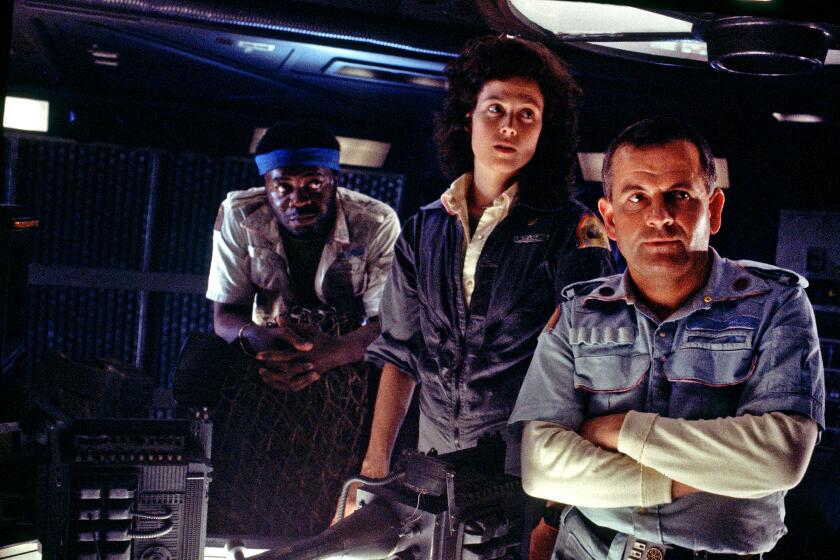UNDER THE SKIN OF 2 VICIOUS LIVES
When Gary Oldman and Chloe Webb arrived at the premiere party celebrating the L.A. opening of “Sid and Nancy,” they were virtually ignored by the swarm of scene makers in attendance, most of whom failed to recognize the stars of the film.
It’s an understandable oversight, given that it’s hard to imagine two people less like the infamous punk lovers whose lives flickered out in a cheap blaze of glory in the late ‘70s.
Oldman, a member of the Royal Court Theater who’s spent the bulk of his career on the London stage, is a soft-spoken, well-mannered 27-year-old chap who admits to listening to Elton John and Rod Stewart when punk was in full sail. Webb, a genial woman of 28 with an easy manner and a contagious laugh, is married to a lawyer, prefers stage to screen acting and seems basically, well, nice . In light of their real-life identities, their performances in “Sid and Nancy”--the first major screen role for each of them--are nothing short of phenomenal.
The second film by hotshot newcomer Alex Cox (who debuted with the critically acclaimed black comedy “Repo Man”), “Sid and Nancy” chronicles the fateful meeting, fiery courtship and ignoble end of Sid Vicious, British bassist with seminal punk band the Sex Pistols, and his American girlfriend, Nancy Spungen. A screeching harridan who introduced Vicious to heroin, Spungen joined Vicious for a drugged-out slide down the sewer that ended in 1978 when Spungen was discovered dead of a knife wound in New York’s Chelsea Hotel. Arrested at the scene of the crime, Vicious was charged with the murder, but died of a drug overdose before he could be brought to trial. Both were 21 when they died.
Cox’s film basically sticks to the facts of this grisly saga and needless to say, it’s a difficult movie to watch. The question arises: Why does their pathetic story warrant retelling? Oldman and Webb made a good case for the film during a recent interview at the Beverly Wilshire Hotel.
“Sid and Nancy’s relationship, the so-called murder and Sid’s death are surrounded by a mystique we hope this film will help dispel,” Oldman explained.
“I don’t think the film is exploitative in any way because above all else, it’s an anti-drug film. Of course, we can’t market it as an anti-drug film because to put bums in seats, a movie’s got to have icing.
To prepare for the film, Oldman lost 30 pounds, perfected a dead-on impersonation of Vicious’ performing style (Oldman does all his own singing in the film) and met with Vicious’ mother, Anne Beverly, who gave him her son’s favorite accessories, a padlock on a chain and a leather spike bracelet, which Oldman wears throughout the film.
Webb met Nancy Spungen’s sister, Susan, and both Webb and Oldman spent weeks wading through volumes of print written about the couple and talking with people who’d known them.
“People should remember that the film doesn’t profess to be a history of punk. It’s the story of an intense relationship between two eccentrics,” Webb said. “Even within the punk world, Sid and Nancy were very unconventional. Most punks sneered at the idea of romantic love, but Sid and Nancy went around kissing and holding hands. Naturally, we had to cheat a bit here and there because how could anyone know what went on between them when they were alone together? You just try to get a clear idea of the character and remain true to that spirit.”
“Reality is slightly enhanced throughout the film,” Oldman added. “There are places where it’s quite cartoonish, but so were their lives. And we admit to taking some poetic license with the facts. For instance, the last 20 minutes of the film are essentially improvised. Alex had originally written the final scene as a suicide pact, but after all the research I did, I was convinced it wasn’t a suicide pact and that Sid didn’t murder her.”
“Gary and I were very much of the same mind as to how the final scene should be played,” agreed Webb. “Most people are unaware that because a junkie’s blood gets very thin, Nancy bled to death with a knife wound only a half-inch deep. What happened to them wasn’t planned, nor was it an act of malice. Given their personalities and the way they lived, the random drug taking they indulged in, it was an accident waiting to happen.”
Making the film was excruciating, they said.
“When we were shooting the film, I sometimes thought we were too far into it, but seeing it in its completed form, I realize we worked at absolutely the right level,” Webb said. “It was an extremely depressing film to make and, depending on who you talk to, some people would say Gary and I were really pulled under during the shooting. The film was more or less shot in sequence and it was like being on a road trip that grew increasingly oppressive. Sid and Nancy’s world got smaller and smaller, they saw other people less and less and grew increasingly obsessed with each other. Toward the end of the film, it’s as if Gary and I were alone together on a filthy mattress that was like a tiny life raft.”
Oldman and Webb have yet to unravel the sad mystery of Sid and Nancy. A media centaur--half man, half poster--who fell for the punk party line hook, line and sinker, Vicious groomed himself for history from the start, while Nancy was, by all accounts, a hysterically miserable girl who, despite a privileged upbringing, found life intolerable. Oldman and Webb make no bones about the fact that Sid and Nancy threw their lives away stupidly and willfully, yet they speak of the couple with empathy.
“They were young and naive and were living in an environment where drug use was encouraged,” Oldman concluded. “They simply fell for a very bad package of illusions.”
“Even with all the research we’ve done into them, it’s hard to say what drove them to live the way they lived,” Webb reflected. “I tried to convey that Nancy’s rage grew out of pain and disappointment, but I also hope it’s clear that I found nothing cool about Sid and Nancy. Their lives were completely pathetic. Still, we intended for the audiences to sympathize with them. We certainly did.”
More to Read
Only good movies
Get the Indie Focus newsletter, Mark Olsen's weekly guide to the world of cinema.
You may occasionally receive promotional content from the Los Angeles Times.










